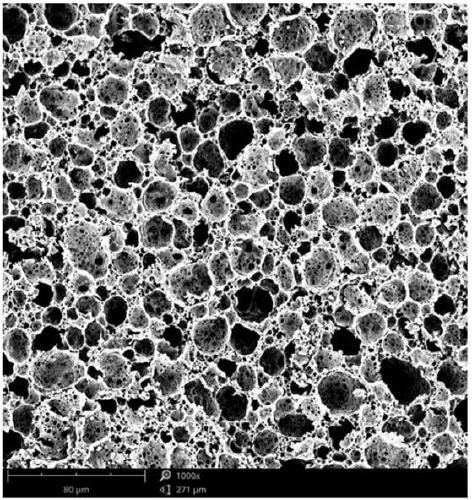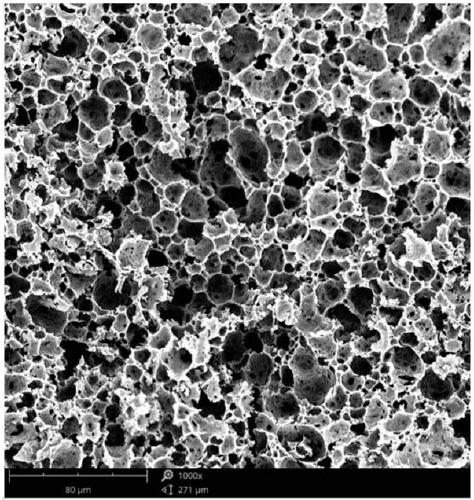Pressure-sensitive polymer syntactic foam with through-cell structure and preparation method thereof
A technology of through-hole and composite foam, which is applied in the field of pressure-sensitive polymer composite foam and its preparation. It can solve the problems of complex preparation process, low material strain sensitivity, and low specific surface area of the skeleton, so as to achieve a wide range of monomers and increase the specific surface area. , the effect of high response sensitivity
- Summary
- Abstract
- Description
- Claims
- Application Information
AI Technical Summary
Problems solved by technology
Method used
Image
Examples
Embodiment 1
[0050] 1. Preparation of oil phase:
[0051] (1) Mix 0.7 g of methyl methacrylate, 0.55 g of butyl acrylate, 0.45 g of propyl acrylate, 5.67 g of isooctyl methacrylate and 0.81 g of divinylbenzene to obtain a mixed monomer.
[0052] (2) Add 2.6 g of Span 80 and 0.03 g of azobisisobutyronitrile to the mixed monomer obtained in (1), and mix uniformly to obtain an oil phase.
[0053] 2. Preparation of Aqueous Phase
[0054] 20 grams of graphene oxide aqueous dispersion (the concentration of graphene oxide aqueous dispersion is 5 mg / g, graphene oxide sheet size is 200nm), 0.2 gram of ascorbic acid and 0.171 gram of sodium chloride, are added to 30 mL of deionized water An aqueous phase is obtained. During this period, the ultrasonic method can be used to assist the uniform dispersion of graphene oxide.
[0055] 3. Preparation of Pressure Sensitive Foam
[0056] First, pour the oil phase into a three-port glass reactor, and slowly add the water phase to the oil phase under stir...
Embodiment 2
[0059] 1. Preparation of oil phase:
[0060] (1) Mix 0.68 g of styrene, 0.72 g of butyl acrylate, 5.88 g of isooctyl methacrylate and 0.41 g of ethylene glycol dimethacrylate to obtain a mixed monomer.
[0061] (2) Add 0.87 g of Hypermer A70 and 0.06 g of azobisisobutyronitrile to the mixed monomer obtained in (1), and mix uniformly to obtain an oil phase.
[0062] 2. Preparation of Aqueous Phase
[0063] 20 grams of graphene oxide aqueous dispersion (the concentration of graphene oxide aqueous dispersion is 5mg / g, graphene oxide sheet size is 500nm), 0.25 grams of ascorbic acid and 0.09 grams of anhydrous calcium chloride, were added to 50mL of deionized Prepare the aqueous phase in water. During this period, the ultrasonic method can be used to assist the uniform dispersion of graphene oxide.
[0064] 3. Preparation of Pressure Sensitive Foam
[0065] First, pour the oil phase into a three-necked glass reactor. Slowly add the water phase to the oil phase under stirring ...
Embodiment 3
[0068] 1. Preparation of oil phase:
[0069] (1) Mix 0.4 g of styrene, 0.68 g of butyl acrylate, 7.23 g of isooctyl methacrylate, and 0.9 g of divinylbenzene to obtain a mixed monomer.
[0070] (2) Add 1.8 g of Hypermer A70 and 0.08 g of benzoyl peroxide to the mixed monomer obtained in (1) and mix evenly to obtain an oil phase.
[0071] 2. Preparation of Aqueous Phase
[0072] 20 grams of graphene oxide aqueous dispersion (the concentration of graphene oxide aqueous dispersion is 1mg / g, graphene oxide sheet size is 100nm), 0.3 gram of ascorbic acid and 0.02 gram of potassium nitrate, 0.02 gram of sodium nitrate are added to 55mL Prepare the aqueous phase in deionized water. During this period, the ultrasonic method can be used to assist the uniform dispersion of graphene oxide.
[0073] 3. Preparation of Pressure Sensitive Foam
[0074] First, pour the oil phase into a three-necked glass reactor. Slowly add the water phase to the oil phase under stirring at 450rpm; after...
PUM
| Property | Measurement | Unit |
|---|---|---|
| pore size | aaaaa | aaaaa |
| pore size | aaaaa | aaaaa |
| pore size | aaaaa | aaaaa |
Abstract
Description
Claims
Application Information
 Login to View More
Login to View More - R&D
- Intellectual Property
- Life Sciences
- Materials
- Tech Scout
- Unparalleled Data Quality
- Higher Quality Content
- 60% Fewer Hallucinations
Browse by: Latest US Patents, China's latest patents, Technical Efficacy Thesaurus, Application Domain, Technology Topic, Popular Technical Reports.
© 2025 PatSnap. All rights reserved.Legal|Privacy policy|Modern Slavery Act Transparency Statement|Sitemap|About US| Contact US: help@patsnap.com



